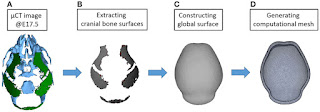Many
neurological and psychiatric disorders are currently difficult or even
impossible to treat; nearly 100 million people are suffering worldwide.
Recently research proposed the bioengineered cranial bones with multiple intelligent functions that include neurotoxin drainage with EEG feedback, site
specific trans meningeal drug delivery and it can also provide effective
treatment for brain disorders by drug combinations that act on both synapses
and genes. Finally after demonstrating the safety and anticonvulsant efficacy
of this complex procedure on nonhuman primates, they confirmed that
bioengineered cranial bones with multiple intelligent functions have realistic
medical/therapeutic potential.
Friday 30 September 2016
Thursday 29 September 2016
Enhancing Visual Evoked Potentials Detection with Use of Computational Intelligence Tools
The analysis of evoked potentials
(EPs) in the electroencephalogram (EEG) is usually inspected visually and
demands subjective interpretation of the results. This paper aims at combiningan statistical criterion based on the magnitude square multiple coherence(MSMC) estimate with computational intelligence methods in order to estimate
the EPs detection rate (DR) using only portions of the frequency spectrum.
Thus, networks were used to predict the DR in EEG signals of 15 normal subjects
during stroboscopic stimulation. The algorithms were designed to receive thespectral information of two, four or six EEG derivations as the input and DR asthe output. Our best result shows that the artificial neural networks can
estimate DR with correlation coefficient of 0.97 compared with MSMC, even when
a reduced amount of spectral information from the data is available.
Wednesday 28 September 2016
Therapeutic role for Emodin against Alzheimer’s and Cancer
Rhubarb
is a herb, used widely in conventional treatments; also this plant is the first
source of Emodin. This Emodin is a potential anti-inflammatory and anti-canceragent; it successfully induces- down regulation of cancer inducing genes and
apoptosis. Modification of Emodin and its derivatives successfully increase
various cellular pathways like NF κβ, ROS, MAPK signalling pathway. These
derivatives are also used in Alzheimer’s disease by inhibiting proteases and
microtubule – associated proteins. The properties of Emodin proved to be a
promising solution for many health complications in human.
Tuesday 27 September 2016
Editorial for International Journal of biomedical Data Mining
This
issue of the International Journal of Biomedical Data Mining presents two
contributed articles. The first article, entitled Data Inventory for CancerPatients Receiving Radiotherapy for Outcome Analysis and Modeling, authored by
Jason Vickress, Rob Barnett and Slav Yartsev, describes a database created for
storing and analyzing patient specific data related to pre-treatment condition,
treatment planning, and treatment outcomes, for patients receiving radiotherapy
based cancer treatment.
The proposed database can perform automated analysis
regarding quality assurance, dose accumulation for multiple treatments on
different machines and can assist physicians in choosing the optimal radiation
therapy for new patients. The second article, entitled Likelihood Ratio Test ofHardy-Weinberg Equilibrium Using Uncertain Genotypes for Sibship Data, authoredby Qiong Li, Helene Massam and Xin Gao, is concerned with the problem of
testing for Hardy-Weinberg equilibrium of genotype frequencies in the area of
population genetics.
Friday 23 September 2016
Sequence Features and Subset Selection Technique for the Prediction of Protein Trafficking Phenomenon in Eukaryotic Non Membrane Proteins
Eukaryotic
cells are organized into several membrane bound compartments. In order toperform the function; newly formed proteins get sorted and are delivered to
various compartments in the non-membrane and trans-membrane pathways.
This
protein sorting process in the pathway is very complex and still not clearly
understood. But the most important principle of protein trafficking is that
each protein has the information on its final localization site as a part of
its amino acid sequence. In 1983, Nishikawa, Kubota and 0oi had conductedinvestigations into predicting subcellular locations based on amino acidcompositions. They had reported that the amino acid compositions have the discriminating
ability to classify subcellular locations.
Bioinformatics tools in Viral and Cancer biology
Molecular biology and genomic tools are advanced techniques
widely used in research fields. These tools can generate huge amount of data atthe same time they can compile and analyse. Bioinformatics tools such as Fast
QC and htSeq tools are used for analysing quality of short reads, correlation
between mutant, genes and pathway can be done by tool MuSiC etc.. Next
generation sequencing tool helps to get information in low cost, time and
labour. Application of such type of tools in virology and cancer biology
provides advanced information and sequencing data for further research.
Thursday 22 September 2016
Data Inventory for Cancer Patients Receiving Radiotherapy for Outcome Analysis and Modeling
Data collection for cancer patients is recognized as an
important task in the USA, where the National Program of Cancer Registries
(NPCR) administered by the Centers for Disease Control and Prevention collects
data on the occurrence, type, extent, and location of the cancer, and the type
of initial treatment.
The International Consortium for Health Outcomes
Measurements (ICHOM) aims at providing a global resource of in-use outcome
measures and risk adjustment factors by medical condition and creating a global
standard for measuring results. These initiatives will enable public healthprofessionals to understand and address the cancer burden more effectively. We
have recently proposed to use the pre-treatment, planning, and treatment
outcomes data for cancer patients undergoing radiation therapy to provide
guidelines for optimal choice of both radiation modality and planning for new
patients.
It is important to determine the most influential patient features
(or their combinations) that has the strongest correlation with the outcomes.
We propose an Overlap Volume Histogram as a valuable representation of size andshape for tumor and organs at risk important for planning.
Tuesday 20 September 2016
Understanding Dive Computers
Modern digital dive computers date to the early 80s, though
analog devices simulating tissue gas uptake and elimination through porous
membranes date back to the 70s. Analog devices were limited to nonstop divingand had a short shelf life.
Digital dive computers proved highly successful and
very useful right from the start, progressing from just table emulators to full
up algorithmic staging devices across mixed gas, open circuit (OC), rebreather
(RB), nonstop, decompression, deep, and shallow diving. Dive computers aremoderately expensive items these days, and high end units range beyond $1500.Basically, a decompression computer is a microprocessor consisting of a powersource, pressure transducer, analog to digital signal converter, internal
clock, chip with RAM (random access memory) and ROM (read only memory), and
pixel display screen. Pressure readings from the transducer are converted to
digital format by the converter, and sent to memory with the elapsed clock time
for model calculations, somewhere in 3-10 second intervals.
Monday 19 September 2016
A Revolutionary Method of Treatment
A tumor without a supporting network of blood vessel
formation is like a car without wheels-it’s not going anywhere!
But the multiple hemangioperycitoma type of brain tumors I’ve
been shackled with over the last fourteen years were multiplying rapidly in the
cancer lane and were driving me one hundred and ten miles an hour to my grave!
That was until suddenly, in early March, 2003, when
Providence unexpectedly whisked me away from my home in Burbank, CA and guided
me directly to the one person, who was to change my life forever so that Iwould be free of any new or recurring tumors of any variety, have a quality
life and even have it extended several years! He is Mr. Nick Kostovic, a
pioneer and visionary in energetic medicine, and his health clinic, the Bio
Technological Health Center, Inc., in San Pedro, California is where he not only
killed my malignant brain tumors, but where this brilliant, caring therapist is
helping heal my malignant brain tumors, but where this brilliant, caring
therapist is helping heal many other patients by eradicating other treacherous life
threatening diseases such as diabetes, cancer, Lou Gehrig’s Disease (ALS),
Parkinson’s, MS, strokes and more.
Friday 16 September 2016
Solid-phase Immuno Radio Metric Assay (IRMA) of 25-hydroxy Vitamin
Vitamin D is a steroid hormone involved in the active
intestinal absorption of calcium and regulation of calcium homeostasis. It is
essential for the formation and maintenance of strong, healthy bones. Vitamin Dhas other roles in the body, including modulation of cell growth, neuromuscularand immune function, and reduction of inflammation. Vitamin D has two isomers:
vitamin D2 (ergocalciferol) and vitamin D3 (cholecalciferol). Vitamin D2 is
obtained from dairy product whereas Vitamin D3 is produced in the skin after
exposure to ultraviolet light. In the liver Vitamin D is hydroxylated at its
carbon 25 to form 25(OH) D. This metabolite is the predominant circulating form
of vitamin D and is considered to be an accurate indicator of the general
Vitamin D status on an individual.
Thursday 15 September 2016
Sequence Features and Subset Selection Technique for the Prediction of Protein Trafficking Phenomenon
Protein trafficking or protein sorting is the mechanism by
which a cell transports proteins to the appropriate position in the cell or
outside of it. This targeting is based on the information contained in theprotein. Many methods predict the subcellular location of proteins in
eukaryotes from the sequence information. However, most of these methods use a
flat structure to perform prediction.
In this work, we introduce ensemble
methods to predict locations in the eukaryotic protein-sorting non membrane
pathway hierarchically. We used features that were extracted exclusively fromfull length protein sequences with feature subset selection for classification.
Sequence driven features, sequence mapped features and sequence autocorrelation
features were tested with ensemble learners and classifier performances were
compared with and without feature subset selection technique.
Wednesday 14 September 2016
Old Wine in a New Bottle: Harnessing the Therapeutic Properties of Emodin Derivatives
Studies involving mechanism of emodin, an herbal extract, has
revealed its potential as anti-inflammatory, antioxidant and anti-cancer agent.
Emodin has been shown to successfully induce apoptosis, down-regulate cancerinducing genes, proving it to be a therapeutically significant pharmacophore.
Modification of emodin and synthesis of various derivatives have successfully
increased efficacy of the molecule in regulating various cellular pathway like
MAPK signaling pathway, NF-κβ signaling pathway, ROS mediated pathways and
apoptotic pathways.
With the advent of various, anti-bacterial properties of
emodin may come in rescue to combat emerging drug resistant microbial and
parasitic strains. Different emodin derivatives, including the recentlyreported haloemodin, which inhibits bacterial topoisomerases, can be designed
to generate future drugs against resistant pathogens. Emodin derivatives can
also inhibit proteases and microtubule-associated proteins, which play an
important role in Alzheimer’s disease. Properly designed drug delivery systems
like liposomes and nanoparticles have been reported as efficient emodin
carriers and to enhance emodin activity in cancer cell inhibition.
Tuesday 13 September 2016
Cytotoxic Effects of Aflatoxin B1 Standard in Relation to Aflatoxin Extracts
Aflatoxins [AFs] are a group of mycotoxins produced as
secondary metabolites notably by Aspergilliusflavus and A. parasiticus. Otherspecies such as A.nomius, A. bombycis, A. ochraceoroseus, A. pseudotamarii, A.tamarii, and A. australis are also recognized producers.
There are four main
types of aflatoxins; aflatoxin B1(AFB1), AFB2, AFG1 and AFG2, owing to their
colour [blue and green, denoted by the letters] and retardation factor (RF)
when viewed under UV light. The most important of these four toxins in terms ofprevalence and abundance is AFB1. Aflatoxin B1 is also the most potent of all
AFs and has been classified as a Class 1 carcinogen by the International Agency
for Research on Cancer, IARC. This natural toxin is commonly reported to induce
various health effects in humans and animal species; which could be
hepatotoxic, mutagenic, genotoxic or carcinogenic. Chronic exposure to low
levels of AF may well be a risk factor involved in the etiology of
hepatocellular carcinoma and immune system suppression/dysfunction.
Monday 12 September 2016
Preliminary Development of a Magnetically Assisted Test Strip (MATS) Cartridge
Preliminary development of a simple mesofluidic multi-channel
plastic cartridge with underlying external magnet to drag DNA aptamer-coated
paramagnetic beads through fluids in the channels while developing a sandwich
assay with quantum dot-conjugated reporter aptamers is described.
This approach
is superior to traditional lateral flow test strips in several ways including:
- The ability to control the speed of lateral flow in the channel versus conventional nitrocellulose analytical membranes with fixed wicking times.
- The use of aptamers for potentially greater affinity and consistency from batch-to-batch versus comparable antibodies.
- Superior fluorescence efficiency and intensity provided by quantum dots versus conventional fluorescent dyes and
- The ability to multiplex based on the various colored emissions of different sized quantum dots when excited with a single ultraviolet source.
Development of the system from concept to prototype isdescribed along with illustration of sensitive system performance for severalfood safety-related targets. The system is also clearly adaptable to rapid
multiplex detection and sensitive quantitation of clinical biomarkers, drugs,
environmental, veterinary or other target analytes.
Friday 9 September 2016
Intraductal Carcinoma of the Prostate Diagnosed by Multi-Parametric Prostate Magnetic Resonance Imaging (MRI)
Intraductal carcinoma of the prostate (IDC-P) is an
aggressive form of prostate cancer (CaP) with clinical and pathological
features distinguishing it from high-grade prostatic intraepithelial neoplasia
(HG-PIN). IDC-P is characterized by a high volume and high-grade disease, with
an aggressive behavior. We present the case of a 63-year-old male withdiagnostic MRI imaging indicative of IDC-P. To our knowledge, this is the first
reported case of IDC-P identified with multi-parametric MRI.
Although, the term
“intraductal carcinoma of the prostate” (IDC-P) was first used by Rhamy, McNeak
and Yemoto, were the first to delineate IDC-P as a distinct biological entity
with definable histological and clinical features. IDC-P is defined as aproliferation of malignant prostate adenocarcinoma cells distending orcompletely spanning the lumen of pre-existing prostatic ducts and acini, with
at least focal preservation of basal cells. Watts et al. estimated the
incidence of IDC-P to 2.8% in prostate biopsies.
Thursday 8 September 2016
Are Kinematic and Kinetic Analyses Useful to Evaluate Patellofemoral Disorders in the Clinical Practice?
Current
methods for the assessment of the outcome after anterior knee pain (AKP) or
lateral patellar instability treatment have several limitations, for example
their subjectivity. Therefore, new technologies are needed to objectivelyevaluate the outcomes of treatments for patellofemoral disorders and also to
compare different methods of treatment.
The ideal situation would be to
evaluate these patients during dynamic activities that trigger or aggravate the
symptoms (i.e., pain and/or instability), under realistic loading conditions.
We believe that this objective could be reached by means of kinematic andkinetic analysis. The aim of this paper is to analyze the two main reasons for
consultation in patellofemoral disorders (i.e., pain and instability) in our
daily clinical practice from a kinematic and kinetic point of view emphasizing
on the clinical relevance of our biomechanical findings.
Wednesday 7 September 2016
Shikimate Kinase of Yersinia pestis: A Sequence, Structural and Functional Analysis
Yersinia
pestis, the causative organism of Plague, is widely recognized as a potential
bioterrorism threat. Due to the absence of homologs in human, Shikimate Kinase
(SK) is considered as an excellent drug target in several bacterial and
protozoan parasites.
Ample literature evidences confirm the suitability of this
protein as a good target. Therefore, Shikimate Kinase of Shikimate pathway inYersinia pestis represents an attractive drug target. In the present study, a
clustering approach was undertaken to select the proper representative for
Shikimate Kinase sequences belonging to Yersinia pestis for structure
determination.
Three-dimensional models of the enzyme for KFB61218.1 (SK1),
EFA47400.1 (SK2) and WP_016255950.1 (SK3) were generated using a comparative
molecular modeling approach where structures were developed using the single
specific template as well as multiple closely associated templates. Thestructures of Shikimate Kinase developed using comparative modeling were evaluatedfor stereochemical quality using various structural validation tools. Results
from structural assessment tools indicated the reasonably good quality of
models.
Tuesday 6 September 2016
Bioengineered Cranial Bones with Multiple Intelligent Functions
Many neurological and psychiatric disorders with
predominantly cerebral cortical pathology, including most severe strokes, traumatic
brain injuries, malignant
brain tumours, intractable
focal epilepsies and
dementias such as Alzheimer’s disease are currently
difficult, if not impossible, to treat. This causes suffering in almost 100million people worldwide. We propose that bioengineered cranial bones with
multiple intelligent functions, including site- specific trans meningeal drug
delivery and neurotoxin drainage with EEG feedback, can provide effective
treatment of these brain disorders by drug combinations that act on both
synapses and genes with concomitant selective drainage of harmful extracellular
molecules.
Saturday 3 September 2016
Preliminary Evaluation of the Effects of Cold Atmospheric Plasma Application Rate
Tissue
middle of the road plasma has been utilized as a part of preclinical and all
the more as of late in clinical settings for the debridement of dead tissue and
the evacuation of bacterial biofilms. Cool plasma treatment is a developingfield in medicinal sciences; it is for the most part because of the useful
impacts that low temperature plasma has illustrated: calming, antitumor genic
and hostile to microbial impacts. The upside of chilly plasma treatment over
ordinary warm plasma medications, bend coagulators and desiccators, is that it
takes into account more exact application and hence more controllable impacts
on the tissue. Moreover, frosty plasma treatment demonstrated stimulatory
impacts on wound recuperating and tissue recovery.
Thursday 1 September 2016
Solid-phase Immuno Radio Metric Assay (IRMA) of 25-hydroxy Vitamin D
Vitamin
D is a steroid hormone included in the dynamic intestinal retention of calcium
and regulation of calcium homeostasis. It is vital for the development and
upkeep of solid, sound bones. Vitamin D has different parts in the body,including tweak of cell development, neuromuscular and insusceptible capacity,
and diminishment of aggravation. Vitamin D has two isomers: vitamin D2
(ergocalciferol) and vitamin D3 (cholecalciferol). Vitamin D2 is acquired from
dairy item while Vitamin D3 is delivered in the skin after introduction to
bright light. In the liver Vitamin D is hydroxylated at its carbon 25 to shape
25(OH) D. This metabolite is the overwhelming circling type of vitamin D and is
thought to be an exact pointer of the general Vitamin D status on a person.
Subscribe to:
Posts (Atom)



















